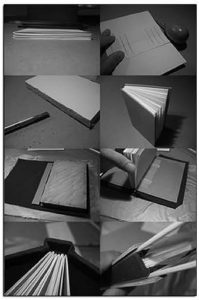
Leather production or tanning of the skin is a physicochemical process in which perishable raw skin, due to physical actions and the effects of chemicals or plants, becomes a non-perishable and valuable product that can be used by humans called leather.
In general, raw skin turns into leather after the following steps:

Initially, the skins are soaked in pools that have blades to move the skins. Cold water then flows onto the salted skin, dissolving the salt in the water. By reducing the concentration of salt in the space between the skin fibers and removing salt from the skin fibers, the osmotic pressure of water inside the fibers will increase and the skin will become hydrated again. At this stage, as water is absorbed into the skin, spherical proteins are removed from the collagen fibers. These isolated spherical proteins contain blood albumin and other water-soluble proteins that dissolve in water as salt decreases and are excreted from the skin. Obviously, the presence of these proteins among the skin fibers reduces the quality of the leather.
– Use of antibacterial agents to prevent the possibility of bacterial regrowth that could harm workers or cause the spread of the disease or damage to three superficial parts of the skin, usually using chlorinated aromatic compounds.
– Pay attention to water temperature: in the soaking stage, if the water temperature is high, it causes the activity of bacteria and its destructive effect on the skin. Although raising the water temperature speeds up the soaking process, raising the water temperature too much lowers the quality of the leather produced and also creates unevenness in the fibers and streaks of the leather.
– Applying additives such as sodium sulfide (S2Na) or sodium tetrasulfide (S2Na) to drinking water, by affecting the hair creatine, loosens the hair roots.
– The soaking time is at least 48 hours and after this time the skin should be washed.
– The skin is cleansed of blood and impurities.
– Water-soluble proteins (spherical proteins) are separated from the skin.
– The chemicals used to maintain and disinfect the skin are separated from it.
– Due to soaking, the skin returns to its natural state by absorbing enough water and tanning is done on it easily.
Liming
In general, the process of lime is to loosen the hair follicles, raise the pH and eliminate or help eliminate excess proteins and fats in the skin in later stages.
Hardened lime (O2CaOH) has low solubility in water and can increase the pH of the solution to 12.5. Hardened lime causes fibrous structure of proteins and gradual decomposition of their structure.
Salted lime will have different effects on the three main proteins in the skin. The solubility of spherical proteins is very high. Collagen also dissolves only in the presence of strong acids and bases for a relatively long time. This calcareous environment breaks down the keratin molecules of the hair and dissolves them without damaging the collagen of the skin and consequently the quality of the leather, and loosens the hair roots to a desirable level. Also, this calcareous environment, by affecting the molecules of elastin proteins, prepares them for complete elimination in the enzyme step and completely destroys the spherical proteins.
After the liming stage, the flossing operation is performed to remove all unnecessary skin tissues that are on the inner surface and without skin hairs. After the skin is completely softened by absorbing water, the appendages attached to the fleshy part that remain after the skin is removed from the carcass are completely removed from the skin along with other excess tissues by a device called a lash bar. This causes the chemicals that are added to the skin in the next step to penetrate evenly and well into the skin and improve the quality of the product.

Hair removal of goat and sheep skins is done by rubbing a solution of lime and sodium sulfide on the skin part of the skin. After rubbing the solution, the skins are divided into 40 to 50 groups in the direction that the skin side is inwards, and thus the classified skins remain in the same state overnight. The hair is then easily separated from the skin by a device.
Basically, sodium sulfide can be used to make the hair removal process take less time. Also, by adding methylamine, lime, sodium carbonate and sodium sulfide, you can remove hair from fresh skin and salt.
In addition, for the removal of heavy skin such as cow, calf, buffalo, etc., the hair removal method is used along with the breakdown of the hair structure, in which the skin is placed at least in balaban (drum) and sodium sulfide and sulfides are used. Sodium is added to the water inside the balaban in a suitable amount and in this way the mowing is done.
In order to remove excess lime and adjust the pH for the enzymatic step, calcium hydroxide 2 (Ca OH) absorbed into the skin must be removed and the pH of the skin lowered. Also, to lower the pH of the acid, it is essential, like hydroelectric acid, to balance the amount of consumables so that the lime dissolves and is easily removed from the skin. Iron and other substances along with the skin can be completely removed from the skin by rinsing with water or acid and ammonium sulfate:
CaCl2 + H2O + HCl2 = CaSO4 + 22H2O + NH3 (Ca (OH2 (CA (OH + 2SO4 (NH4)))))
Calcium hydroxide dissolves well in ammonium sulfate, and because the pH in such an environment will be between 7 and 8, calcium pH is highly soluble in this amount of pH, and in this condition, lime is gradually removed from the skin.
Hydrochloric acid can be used for further degreasing. Lactic acid is used to regulate the pH of skin that will be tanned with plant materials. In addition, in order to remove waste products and absorbed sodium sulfide, the skin should be washed with running water for at least one hour, and after the result is determined by the phenolphthalein detector, the enzymatic phase begins. In the enzymatic stage, the skin wastes are digested and the skin is ready for tanning.
The substances that are removed from the skin at this stage are: non-collagenous proteins, the outer layer of the skin, hair and blemishes on the surface of the skin, hair follicles and skin pores that must be completely removed. Also, to produce high-quality and soft leather, protein fibers that are resistant to chemicals are separated from the skin during the enzymatic stage.
6) In tanning with chromium salts, formic acid, sodium carbonate and other salts are the chemicals that are used. In the tanning process with chromium salts, these salts react with the skin fibers and give a lot of stability to the skin fibers, which makes it resistant to high temperatures and bacterial attack. Hence, leather made with this method does not have many desirable characteristics. Therefore, after the tanning stage, the skin should be strengthened again with chrome or plant materials, and then by oiling and dyeing, the leather should become the desired leather.
In general, chemicals used in the tanning process are divided into three categories:
1- Minerals (chromium salts, aluminum)
2- Plant materials (plant extracts such as oak, pomegranate)
3- Industrial materials (formaldehyde resins)

Leather is a substance produced from the tanning of the raw skins of animals such as cows. Leather is an important material with different uses. The main use of this material is in the shoe industry and it is also widely used in binding. In addition, leather, along with wood, formed the basis of most ancient arts. The leather industry and the fur industry are separate industries that are separated due to the importance of their raw materials. In the leather industry, raw material is a by-product of the meat industry, because meat has more value than skin.
In the animal fur industry, leather is more valuable and therefore meat is a by-product. Animal skins are also used in skin decoration, stuffing of animals with straw and Taxidermy, but generally the head and parts of the back of the animal are used. Of course, leather has other uses as well.
There are several processes by which animal skins become flexible and strong, commonly called leather. Chrome-tanned leather, invented in 1858, is tanned using cream sulfate and other cream salts.
The leather obtained from this method is not only softer and more flexible than the vegetable tanned leather, but also retains its color and shape in water. The type of chromium used in the process should not be confused with chromium hexavalent (which is carcinogenic) but has no tanning properties.
Hexavalent chromium is rarely found in creamy leathers, but if the leather is misplaced and incorrectly bleached, for example, the presence of this substance becomes confusing and astonishing. Vegetable tanned leathers are tanned using tannins, and there are other plant elements and components, bark and similar sources.
This type of leather is soft and its color is brown, the color spectrum of which depends on the combination of skin color and chemicals used. Vegetable tanned leather is not stable in water, it loses its color and if it remains in moisture and then dries, it shrinks, loses its softness and becomes harder. In hot water, it shrinks sharply and takes on a rubbery state, hardening and gradually breaking.
Boiled leather is an example of leather that has been stripped naked by immersion in hot water or similar material. Historical evidence shows that this type of leather was used due to its light weight and hardness in armor as well as in bookbinding.
Aldehyde skins are tanned using glutaraldehyde with oxazolidine compounds. This type of leather is usually produced by tanners as white leather and light cream. This is the most important group of leathers that do not use chrome and are often found in children’s shoes and car seat covers that prefer to use non-chrome leathers. Formaldehyde tanning, another type of aldehyde tanning, is less commonly used because it is dangerous to workers and many people are sensitive to formaldehyde.
Brain tanned leathers, which fall into this category, are exceptionally water-absorbent. They are produced by the arduous process of suspending fats extracted from animal brains. They are known for their exceptional softness and washability.
Very thin leather made from the skin of sheep, goats and deer. This leather is also in the category of aldehyde tanners and, like the previous group, increases the production of leather by absorbing moisture. This type of leather is produced using oil (traditionally a type of fish oil) which is easily oxidized to produce aldehydes used in tanning.
Raw skin is obtained by placing fresh skin in lime and then pulling it out while drying. This material is not technically similar to tanned tan, but is usually in the same category as other types. Rashide skin is drier and more brittle than other types of leather and has uses such as drum covers where it does not require much flexibility; They are also used in the production of embroidered yarns and stitches and with dog chews.
Vegetable leather can usually be lubricated to increase water resistance. This complements the natural oil remaining in the leather itself, which allows the leather to be washed more often. Multiple lubrication of leather with mink oil and similar materials softens the product and increases its durability incredibly.
As you know, Iran is one of the top producers of skin in the world (it has 70 million sheep) and Iranian sheep skin is one of the best skins after Australia, which is due to the presence of a soft fat under the skin, but However, due to the inefficiency of the leather industry, they export salambour or wet blue with very low added value to countries such as Turkey and Pakistan, and unfortunately, unprofessional policies to control the export of these products cause serious damage to the country’s leather industry. he does. Fortunately, in the last few years, the government has forced exporters to export Wet Blue percentage of salambour, which is somewhat more valuable. About 80% will be added to its value, which in addition to high currency, will also employ the youth of this region.
Another point that is noteworthy is that European countries, in order to allow products to enter their country, must first pass European standards and control various laboratory quality, which unfortunately, due to lack of equipment and ignorance of craftsmen to these very attractive markets. No attention was paid by our experienced craftsmen and Turkey and Italy took over this market.
In this article, we will get acquainted with the types of oils used in this industry.
It is obtained by refining cow fat. To do this, the animal fat is boiled in water to melt and then separated from the water. This fat has a melting point of 35 to 38 degrees Celsius, is yellow, hard and has good filling properties. Lubricates good leather without making it too soft or stretchy. Also, if it is not hot during use, it is difficult to penetrate the skin. Its main use is in feeding mixed fats (such as a mixture of tallow and fish oil) to leather.
The presence of fish oil helps the fat to penetrate deeper and deeper into the leather. If this material spoils, it accumulates on the surface of the leather and creates stains.
It is similar to beef tallow, but harder and whiter. Its melting point is 35 to 38 degrees Celsius.
This substance is present in beef tallow. It is a hard, white solid and a type of fatty acid and is the main cause of dandruff in leather.
It is obtained by boiling the venom of various animals (mostly the venom of cattle, sheep and horses) in water. After collecting the oil from the water surface, it is obtained as a thick, pale yellow liquid that does not oxidize and turn blue in the presence of air. The main use of this high-quality oil is in making leathers that are tanned with chromium salts.
This oil has a very good penetration power and at the same time it makes the leather flexible, it also prevents it from becoming too soft. Otherwise, the leather will flake and turn yellow and remove wrinkles. Toxic oil is a type of garlic oil and can be sulfated to dissolve in water.
Fish liver oil, which is obtained by boiling fresh fish liver in water and collecting the separated oils, is a yellowish-brown liquid with a pungent odor of fish and is easily sulfated. It has good penetration power, it is easily oxidized and its color turns blue. After sulfation, these defects become less. A mixture of sulfated fish oil and mineral oil is used to lubricate cumin leathers made with plant materials and second-hand leather leathers
It is obtained from whale fat. The best type is hydrogenated and margarine is made from it. Whale head oil has most of the same properties as wax and its color is yellowish-brown and does not have the bad smell of fish oil. This oil can be sulfated. Its permeability is very high and it is used in making soft leathers for gloves and clothes.
Moellon is a natural leather that is produced by oxidizing the crude oil of fish liver, while trimming the skin of sheep and goats. Synthetic molasses is obtained by aeration under the control of crude fish liver oil. This type of oil dissolves in water and is not stable against acids.
This vegetable oil is obtained by squeezing the coconut skin. Its properties are similar to wool oil. It is superior to white leathers because it does not change color in the light. Sulfated coconut oil solution is used in the lubrication stage.
This oil is obtained by squeezing the seeds of the gerchak plant in the form of a thick and pale liquid. Its mixture with beef tallow oil is called leather oil and it is used to waterproof leathers and also as a softener in leather polishing.
Waxes are abundant in nature and are found in the salivary secretions of some insects, such as bees. In animals and plants, waxes are present as a protective layer. Like whale oil, also called camphor wax. Chemically, waxes are the esterification of ten-carbon or higher fatty acids or one-factor alcohols with more than 10 carbon atoms in their molecules. Are formed.
It is yellow and brittle and is obtained from Brazilian palm. It is an expensive polishing agent for leather and increases its durability. Fingerprint does not remain on it and its color does not darken due to dust and softens the leather.
This wax is obtained by melting the beehive and its melting point is between 60 and 64 degrees Celsius. This wax absorbs dust and has a high adhesion property.
This substance is obtained from the remains of washing the skin in the stage of weathering and wool removal. Its ingredients are different and it is made of some fat (glycerin) and vaccines (alcohol and fatty acids). The most famous type of wool oil is lanolin. Its permeability is high even in mechanical leathers such as belt leather.
Its properties are similar to Carnovia wax and only its melting point is lower.
It is a white wax from which cheap candles are made. Its mixture with resin is the main material for waterproofing tanned leathers with chromium salts. In the leather polishing step, it is mixed with a solvent and water to make a non-viscous wax with a pigment.